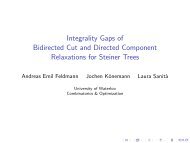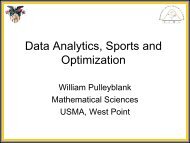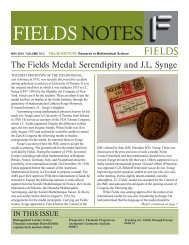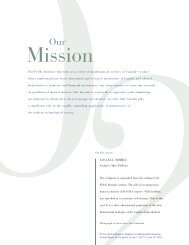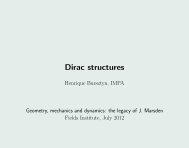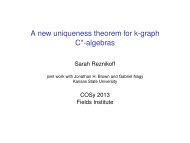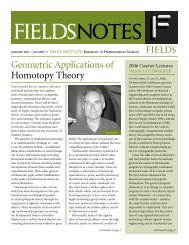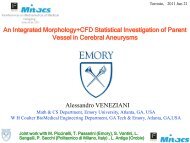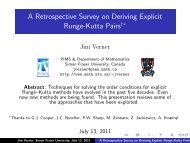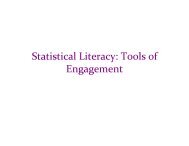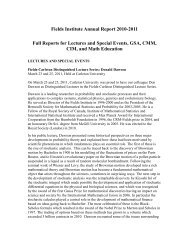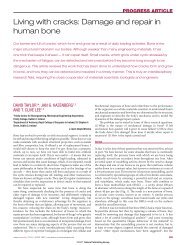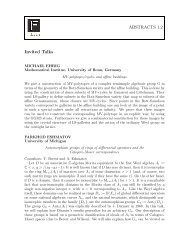Annual Report 2005 - Fields Institute - University of Toronto
Annual Report 2005 - Fields Institute - University of Toronto
Annual Report 2005 - Fields Institute - University of Toronto
You also want an ePaper? Increase the reach of your titles
YUMPU automatically turns print PDFs into web optimized ePapers that Google loves.
This workshop brought together number theorists and<br />
physicists from around the world and was intended as a<br />
satellite workshop to the summer CMS meeting at the<br />
<strong>University</strong> <strong>of</strong> Waterloo, June 4–6. Many participants in the<br />
workshop stayed on for a CMS session on L-functions and<br />
algebraic curves.<br />
The workshop was meant to explore connections between<br />
number theory and random matrix theory. The first connection<br />
between number theory and random matrices<br />
was made in the seventies. Hugh Montgomery had just<br />
worked out the pair correlation statistic for the zeros <strong>of</strong><br />
the Riemann zeta function, and, on a visit to the <strong>Institute</strong><br />
for Advanced Study, was describing his results to Freeman<br />
Dyson. Dyson, who had studied similar statistics for the<br />
eigenvalues <strong>of</strong> random matrices in the context <strong>of</strong> modeling<br />
the energy levels <strong>of</strong> nuclei, pointed out that eigenvalues<br />
<strong>of</strong> large unitary matrices share the same behaviour that<br />
Montgomery had uncovered for the zeros <strong>of</strong> the Riemann<br />
zeta function. This supported the Hilbert-Polya conjecture,<br />
namely that the Riemann hypothesis should be true<br />
because the zeros <strong>of</strong> zeta somehow correspond to the eigenvalues<br />
<strong>of</strong> some unitary operator.<br />
In recent years, there has been a flurry <strong>of</strong> activity in this<br />
area. Montgomery’s results have been shown to extend<br />
to other L-functions <strong>of</strong> number theory. This has led to<br />
insight into questions concerning the value distribution <strong>of</strong><br />
L-functions and ranks <strong>of</strong> elliptic curves. On the other hand,<br />
questions raised by number theorists have stimulated work<br />
on analogous problems in random matrix theory and has<br />
helped to push further the rich subject <strong>of</strong> random matrices.<br />
The workshop included amongst its participants some <strong>of</strong><br />
the number theorists and physicists who have been at the<br />
forefront <strong>of</strong> this approach, as well as a good number <strong>of</strong><br />
post docs and graduate students. It was supported by the<br />
<strong>Fields</strong> and Perimeter <strong>Institute</strong>s, PIMS, and the <strong>University</strong> <strong>of</strong><br />
Waterloo.<br />
Speakers:<br />
E. Bogomolny (Paris-Sud)<br />
Spectral statistics <strong>of</strong> a pseudo-integrable map<br />
O. Bohigas (Paris-Sud)<br />
Spacing distribution <strong>of</strong> zeros <strong>of</strong> Riemann’s zeta function<br />
D. Farmer (AIM)<br />
Example Maass L-functions<br />
G e n e r a l S c i e n t i f i c A c t i v i t i e s<br />
A. Gamburd (Stanford)<br />
Averages <strong>of</strong> characteristic polynomials from classical groups<br />
C. Hughes (Michigan)<br />
The maximum size <strong>of</strong> the zeta function<br />
H. Kisilevsky (Concordia)<br />
Central values <strong>of</strong> cubic elliptic L-functions<br />
P. Kurlberg (KTH)<br />
Poisson statistics via the Chinese remainder theorem<br />
J. Lagarias (Michigan)<br />
Zero spacing distributions for differenced L-functions<br />
F. Mezzadri (Bristol)<br />
Random matrix theory and entanglement in quantum spin<br />
chains<br />
S. Miller (Brown)<br />
Identifying symmetry groups <strong>of</strong> zeros <strong>of</strong> families <strong>of</strong> L-functions<br />
R. Murty (Queen’s)<br />
Dirichlet series and hyperelliptic curves, part 1<br />
N. Ng (Michigan)<br />
Large gaps between the zeros <strong>of</strong> the zeta function<br />
Y. Petridis (City U. & Max-Planck-Inst.)<br />
Modular symbols and discrete logarithms<br />
C. Roettger (Iowa State)<br />
Counting matrices in the general linear group over algebraic<br />
integers<br />
N. Snaith (Bristol)<br />
Derivatives <strong>of</strong> random matrix characteristic polynomials and<br />
applications to elliptic curves<br />
M. Young (AIM)<br />
Moments <strong>of</strong> the critical values <strong>of</strong> families <strong>of</strong> elliptic curves<br />
G. Yu (South Carolina)<br />
Average Frobenius distribution <strong>of</strong> elliptic curves<br />
<strong>Fields</strong> <strong>Institute</strong> <strong>2005</strong> ANNUAL REPORT 82



